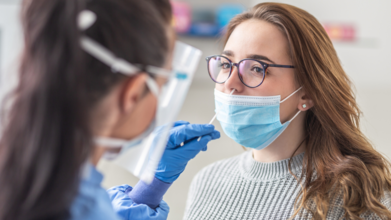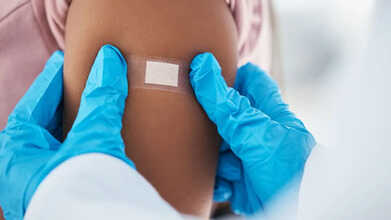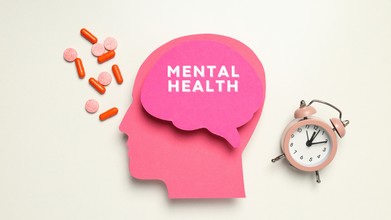- Health Conditions A-Z
- Health & Wellness
- Nutrition
- Fitness
- Health News
- Ayurveda
- Videos
- Medicine A-Z
- Parenting
- Web Stories
COVID Symptoms Are Different In 2025—How Long After Exposure Should You Get Tested?

Credits: iStock
When someone close to you tests positive for COVID-19, it’s natural to feel an immediate sense of urgency. The question that often follows is simple but critical: how long should you wait before getting tested? Testing too soon can give you false reassurance, while delaying too long risks spreading the virus to others. The answer lies in understanding the incubation period, the type of test you use, and the circumstances of your exposure.
COVID-19 doesn’t reveal itself instantly. It takes some time for the virus to reproduce in your body until it can be detected by tests to the level that it is present. That window is called the incubation period, and it is usually 2 to 14 days, with infections usually appearing on days 3 to 7. Waiting too long to test results in a false-negative reading because viral load isn't adequate yet. That is why professionals call for waiting for the appropriate moment before swabbing.
Also Read: What Is Chagas Disease? What Are the Symptoms? Is This 'Kissing Bug' Infection Deadly?
When To Test For COVID If You Have Symptoms?
If you get symptoms like fever, cough, tiredness, stuffiness, or loss of smell and taste—you need to test immediately. A positive antigen test is most often accurate, but a negative one isn't always the end of the matter. Since rapid tests may not catch early infections, particularly within the first days, the FDA and CDC advise retesting 48 hours later if your initial test was negative but you continue to have symptoms.
When to Test for COVID if You Do Not Have Symptoms?
For people without symptoms but with known exposure, the CDC advises testing on Day 5 after exposure. Counting starts on the day of exposure, which is considered Day 0. By Day 5, the virus is typically detectable in most individuals. Testing earlier may be useful if you’re planning to be around vulnerable populations, but it’s important to confirm results later in the incubation period with a follow-up test.
Types of Tests for COVID-19 and Accuracy After Exposure
Rapid Antigen Tests
- Speed: 15–30 minutes.
- Advantages: Suitable for rapid decisions and testing at home.
- Drawbacks: Less sensitive, particularly in the initial periods of infection or among asymptomatic individuals.
- Optimal Use: Day 5 or later since exposure; retest after 48 hours if negative.
PCR Tests
- Speed: Results usually within 1–3 days.
- Advantages: The gold standard because highly sensitive, able to identify even traces of the virus.
- Limitations: Has to be processed in the lab, longer turnaround.
- Best Use: Day 5 after contact for best accuracy.
Antibody Tests
- Speed: Variable, but not useful immediately.
- Strengths: Can identify past infection, not current.
- Limitations: Antibodies typically show up 1–3 weeks after infection.
- Best Use: To ascertain past exposure, not to test right after contact.
Why Testing Too Early Can Give Misleading Results?
Testing within 1–2 days of exposure rarely provides accurate results. At this stage, the virus is still incubating and your immune system hasn’t produced a detectable viral load. A negative result during this period can create a false sense of security, potentially leading to unintentional spread. Waiting until Day 5, unless symptoms appear earlier significantly improves accuracy.
COVID Testing Timeline Guideline
Day 0: Exposure occurs. Begin monitoring for symptoms.
Days 1–3: Remain vigilant. Avoid social contact, but delay testing unless symptoms occur.
Day 5: Test with PCR or an antigen test. If you use an antigen test and it comes back negative, retest in 48 hours.
Day 6–7: If you received a negative test result but are still worried—or must see someone high-risk—opt for a second test.
What to Do if You Test Positive?
A positive test result indicates you should self-isolate right away, notify close contacts, and adhere to public health advice. Most individuals with mild signs or symptoms can recover at home, but individuals with high-risk conditions—e.g., chronic illness, compromised immunity, or advanced age—should see a health care provider for potential antiviral treatment.
Isolation is usually 5 days from onset of symptoms or positive test (in case of being asymptomatic), but at least 10 days of masking around other people is recommended.
What if You Test Negative?
A negative test is not always conclusive. Taken too early, or if you don't have symptoms, the virus may not be visible yet. Keep on masking, watching for symptoms, and retesting as needed. If you have a subsequent onset of symptoms after a negative test, consider the infection to be possible and retest soon.
Where to Get Tested for COVID?
Testing for COVID-19 is widely available in various settings to accommodate a variety of needs. Home rapid tests, found at pharmacies and drugstores, are convenient and provide fast results, but a follow-up test is suggested if the test is negative but symptoms are still present. Healthcare clinics and pharmacies sell antigen and PCR tests, and some have appointments. Free or low-cost testing can be found at community clinics and public health clinics, especially in outbreak situations. For patients with respiratory symptoms, most clinics ask that they pre-call to reduce waiting room exposure, and telemedicine consultations are becoming more widespread throughout many areas.
Even in 2025, with better treatments and vaccines, testing is important. It catches infections early, informs isolation and treatment decisions, and safeguards at-risk populations. The CDC insists repeatedly that prompt testing—particularly following confirmed exposure—is among the best measures to slow spread.
If you’ve been exposed to COVID-19, resist the urge to test right away. Instead, monitor for symptoms and plan to test around Day 5 post-exposure. Use rapid antigen tests for quick answers, but rely on PCR tests for the most accurate results. Regardless of your test outcome, continue practicing precautions, especially around high-risk groups. Testing at the right time doesn’t just protect you—it protects your community.
Getting the Flu Shot? 5 Things Doctors Want You To Know First

Credits: Canva
Can the flu shot make you sick? Do healthy people really need it? Is it possible to catch the flu from the vaccine itself? With so much misinformation circulating, it’s natural to have doubts. Getting vaccinated against the flu, however, remains one of the simplest ways to protect yourself from severe infection.
While it may not guarantee complete immunity, the flu shot significantly lowers your risk of serious illness. Here, we answer some of the most common questions about flu shots and share key things to remember once you’ve had yours.
What Is a Flu Shot and Why Should You Get It?
Influenza, or the flu, is an infection that affects the nose, throat, and lungs, all parts of the respiratory system. The illness is caused by a virus. Most people recover at home with rest, but in some cases, it can lead to serious health problems, especially among vulnerable groups.
The flu vaccine offers the best protection against the virus and its complications for nearly everyone. It reduces your risk of infection and can also prevent severe symptoms that might otherwise lead to hospitalization or death.
Each year, seasonal flu vaccines are designed to protect against the three strains of influenza that experts predict will circulate the most during that flu season.
When Is the Flu Vaccine Available?
In the United States, flu vaccines typically become available in September. The flu spreads most actively during specific times of the year in both hemispheres, known as flu seasons. In North America, these usually stretch from October through May.
Because it takes roughly six months for vaccine production, distribution in the U.S. often begins in late summer.
After getting vaccinated, it takes about two weeks for your body to develop immunity. That’s why September or October is considered the best time to get the shot. However, if you miss that window, getting vaccinated later in the season can still offer valuable protection.
What to Avoid After a Flu Shot?
Getting your annual flu shot is a straightforward process, but a few simple choices before and after can make a difference in how you feel afterward. Medical professionals and nutrition experts suggest a few practical steps to help ensure your experience is smooth and comfortable.
Wear Something You Can Roll Up Easily
“Clothing that gives you easy access to the upper arm is ideal,” said Kenneth J. Perry, a South Carolina-based physician, in an interview with Fox News Digital. Because flu shots are given in the deltoid muscle, wearing a shirt with loose sleeves or layers you can remove easily helps avoid unnecessary discomfort.
Have a Light Snack Before You Go
“You don’t usually need to eat or drink beforehand unless it helps you feel more comfortable,” explained Dr. Michael A. Traub of Crystal Run Healthcare in New York. A small snack, however, can steady your blood sugar and prevent dizziness. According to the U.S. Centers for Disease Control and Prevention (CDC), offering a beverage, snack, or reassurance before vaccination can reduce fainting. Something simple with protein and carbohydrates, such as a banana with peanut butter or yogurt with granola, can help you feel steady during and after your shot.
Stay Hydrated Before and After
There’s no need to drink excessive amounts of water, but staying hydrated supports comfort and recovery. Both the CDC and Immunize.org recommend drinking water before and after vaccination to maintain circulation and prevent fainting. A glass of water before your appointment and steady fluid intake afterward can help, particularly for people who tend to feel lightheaded during shots.
Know How to Ease Soreness
Mild soreness or fatigue after a flu shot is common. “Typical side effects include slight tiredness, headache, and body aches,” said Dr. Traub. Experts recommend gentle movement or light exercise to help reduce discomfort in the arm. Keeping the arm active encourages blood flow and can ease muscle stiffness.
Know What’s Normal and What’s Not
Minor aches or fatigue are expected side effects, but symptoms such as wheezing, difficulty breathing, swelling of the lips or tongue, rash, severe nausea, vomiting, or chest pain require medical attention. If these occur, contact your doctor immediately.
Who Should Get the Flu Vaccine?
The CDC advises annual flu vaccination for everyone aged six months and older, unless there is a medical reason to avoid it.
Getting vaccinated each year lowers your risk of severe illness and death caused by influenza, especially for those in high-risk groups.
People at greater risk include:
- Adults aged 65 and older
- Residents of nursing homes or long-term care facilities
- Young children, particularly those under one year old
- Individuals who are pregnant, planning pregnancy, or recently postpartum during flu season
With New CDC Guidance, Are Pregnant Women Advised to Get the COVID Vaccine?

Credits: Canva
Pregnant women covid vaccine: Pregnant women hoping to get a COVID shot could face more difficulty accessing it this year. Although leading medical organizations still advise that pregnant women receive the vaccine to protect both themselves and their babies, recent moves by federal health authorities have caused uncertainty over whether the shots are essential during pregnancy.
For those unversed, in May, the Centers for Disease Control and Prevention removed its official recommendation for pregnant women to receive the vaccine. This week, the CDC rolled out new COVID-19 vaccine guidance, but it does not clearly spell out what pregnant women should do.
Dr. Neil Silverman, professor of clinical obstetrics and gynecology at the David Geffen School of Medicine at UCLA, calls this episode another chapter in the ongoing "battle over public health." With respiratory virus season approaching, experts stress the need to reaffirm that COVID-19 vaccines are both safe and necessary during pregnancy. Here’s what you should know.
Should Pregnant Women Get a COVID-19 Vaccine?
Generally, yes, experts say. Current guidance from ACOG and the Society for Maternal-Fetal Medicine recommends that patients receive a COVID-19 vaccine at some point while trying to conceive, during pregnancy, or while breastfeeding.
The vaccine is considered safe for pregnant women and can greatly reduce the risk of severe COVID-19 complications, according to the data. This is particularly important because pregnancy increases the risk of serious COVID-19 outcomes, including hospitalization, pregnancy loss, and stillbirth.
Even a mild COVID infection can cause fever or discomfort, which may lead to complications, Brandt explains.
The recommendations also note that vaccination during pregnancy provides protection for newborns in the first few months of life, when they are too young to be vaccinated themselves.
What Does the CDC Say About the COVID Vaccine in Pregnancy?
Earlier, the CDC’s guidance for COVID-19 vaccination in pregnancy aligned with professional medical groups. That changed when Health and Human Services Secretary Robert F. Kennedy Jr. bypassed the standard review process and announced the CDC would no longer recommend routine COVID vaccination for "healthy pregnant women," NBC News reported.
In September, the CDC’s advisory panel, the Advisory Committee on Immunization Practices (ACIP), voted on updated COVID vaccine guidelines. However, the panel chose not to make a specific recommendation for pregnancy, leaving the decision to CDC officials.
Most recently, the CDC approved ACIP’s decisions, which require anyone receiving a COVID vaccine to engage in “shared clinical decision-making” with a doctor, nurse, or pharmacist beforehand. The agency still has not issued explicit guidance specifically for pregnant women.
Still, federal health officials highlighted that, under the new recommendations, "the risk-benefit of vaccination in individuals under age 65 is most favorable for those who are at an increased risk for severe COVID-19," which includes pregnant people, according to the CDC’s list of high-risk conditions.
Experts recommend that the first step for pregnant women considering a COVID vaccine is to speak with their OB-GYN. They should also ask if their doctor knows of local sites offering vaccinations specifically for pregnant patients. Common places to receive the vaccine include pharmacies, medical offices, and outpatient clinics.
Tired Of Work, Going Through A Burnout? Science May Soon Read Your Mind, Explain Experts

Credits: Canva
As the world observes World Mental Health Day, conversations around burnouts, work culture, whether toxic or healthy, and mental health has become more so urgent than ever. While some are learning to set boundaries through quiet quitting- a process when an employee mentally and emotionally checks out from their job, doing only the bare minimum required by their role without going "above and beyond"; others are also trying to explore neuroscience tools that could revolutionize the way we understand and treat mental health issues.
Quiet Quitting Is the Subtle Cry Against Burnout
Dr. Madhusudan Singh Solanki, Senior Psychiatrist and Head of the Department of Mental Health & Behavioral Sciences at Max Smart Superspeciality Hospital, says that quiet quitting, doing only what one’s job requires, can often be a manifestation of silent burnout.
“When burnout sets in due to high stress, overwork, or a toxic work culture, employees lose their drive and energy. They do the bare minimum to hold on to their jobs, which we now popularly call quiet quitting,” explains Dr. Solanki.
He adds that while setting limits at work can sometimes be healthy, a prolonged state of disengagement could be a red flag. “If emotional withdrawal continues for too long, it may point to dissatisfaction or mental health struggles. That’s when it begins to hurt relationships, productivity, and self-worth,” he notes.
Is Overworking A Badge of Honor?
Research has shown that working beyond 50 to 55 hours a week has damaging effects. It can cause anxiety, sleep disturbances, and burnout to an extent that it can lead to physical illness including heart diseases or chronic illness like diabetes.
“Long working hours don’t translate into better output,” says Dr. Solanki. “In fact, they reduce productivity and can lead to strained personal lives and poor mental health.”
He emphasizes that organizations play a crucial role in preventing burnout. “Employees are human beings with lives beyond work. When organizations create healthy work policies—like fixed hours, breaks, fair compensation, and mental health support—it not only protects employees but boosts loyalty and productivity in the long run.”
Quiet quitting, he says, can sometimes be a temporary act of self-preservation if used to reset work-life balance. But left unchecked, it risks turning into chronic disengagement and even depression.
The Science Of Healing
While one part of the world is learning to cope with burnout, another is working to decode the brain itself. According to Dr. Anant Jain, Assistant Professor of Neuroscience at CHINTA, TCG-CREST, technological breakthroughs are opening up new frontiers in understanding how mental illnesses develop, and how they might be treated in the future.
“The brain is extraordinarily complex, and mental health disorders often stem from very fine molecular and circuit-level disruptions,” he explains. “By observing how neurons communicate and adapt during learning or stress, we can start identifying what goes wrong in disorders like depression, autism, or Alzheimer’s.”
Scientists have now developed genetically encoded biosensors that allow them to watch cellular processes in real time—like how energy (ATP) is produced in neurons during learning or how protein activity changes during memory formation. “These ultra-sensitive tools can help detect dysfunctions early, before symptoms even appear,” says Dr. Jain. “That means future therapies could be more targeted and preventive rather than reactive.”
Using two-photon imaging and optogenetics, researchers can now visualize and even manipulate specific neural pathways in animal models. This precision could pave the way for treatments that restore normal brain function without the broad, side-effect-laden impact of current drugs.
By linking brain activity directly to mental states, these innovations promise to transform mental health care from a trial-and-error approach into one driven by data and individual biology. “We’re moving toward precision medicine, where treatments are tailored to each person’s neural patterns,” Dr. Jain says.
© 2024 Bennett, Coleman & Company Limited

